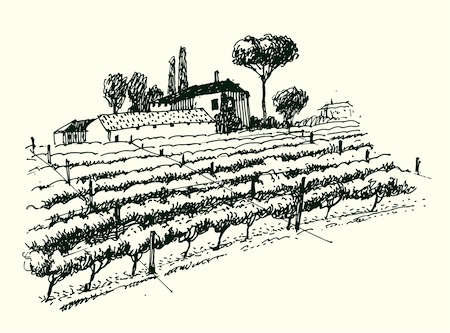
12 Nov Frances Mayes: Devil in a Blue Apron
Lonely Planet’s new anthology, “A Fork in the Road,” presents 34 stories that explore the intersection of travel, food, and cultural epiphany. Each of the pieces in the book, writes editor James Oseland in his introduction, “says something ineffable about how we process and remember tastes and sensations, and about how they alter our view of the world.” The collection’s riches and revelations are abundantly represented in the story we excerpt here, by best-selling author Frances Mayes. Mayes had written six books of poetry and “The Discovery of Poetry” before she bought a house in Italy and spontaneously began writing prose. “Under the Tuscan Sun,” “Bella Tuscany,” “Every Day in Tuscany,” and numerous other books followed. Her works have been translated into over forty languages. She and her poet husband, Edward Mayes, live in North Carolina in a community of writers and artists, and in Cortona, Tuscany. “Under Magnolia: A Southern Memoir” will be published in 2014.

A long, long time ago, before glorious farmers’ markets bloomed, before the non-stop Food Network, recipe blogs, celebrity cooks trying not to look foolish on “Iron Chef,” before the proliferation of excellent food magazines, and even before rampant obesity (resulting from torturous attitudes toward eating), before foams, gluten crazes, before food became cult, and way before every third mas, villa, and farm kitchen in France and Italy became a cooking school, I journeyed far to study with Simone Beck in Provence.
What propelled me across the Atlantic in those dim years? My husband was sailing all the time he was not working. My daughter was entranced with her horse. I often felt that I was flying around my room, a bird come in through the chimney. I wanted to be a writer but kept cooking instead. Go somewhere new, I thought. My friend Jeannette called to tell me about the cooking classes and before she finished the sentence, I said, ‘Let’s go.’
We were five at Simone Beck’s honey-colored house, La Campanette, in the hills above Grasse: Jeannette, also from San Francisco, two pretty and accomplished young women from Atlanta, and a woman from South Africa who was sent there while her boyfriend went on vacation with his wife. Jeannette and I had cooked our way through “Mastering the Art of French Cooking,” which Simca (as everyone called Simone) co-authored with Julia Child. We were adept at dinner parties featuring cream soups, veal Prince Orloff, Grand Marnier soufflé, and other time-consuming, flamboyant, delicious recipes. We loved her book, “Simca’s Cuisine,” her straightforward approach, and immediately liked her no-nonsense rigor in the kitchen. On the first day she gave each of us an apron that matched her impression of us. Mine was plain blue, while the others got charming flowers and stripes. Simca was cordial to us, but not friendly. When Cathy from Atlanta asked one question too many, Simca cut her off with, “Are we going to measure or are we going to cook?” We worked in the morning, and then enjoyed a sumptuous lunch on the terrace. Fish mousseline with hollandaise, pizza with pastry crust, sole in ring mold with velouté, and various sausages in brioche—not exactly Sunday night suppers but still easy and fun. Simca demonstrated. We were assigned small tasks. We took notes. We did not clean up.
If one of us asked a question, she usually looked incredulous through her tinted glasses and curtly said, “But you have it in de Mastering,” as if we should have memorized the whole tome. But I was learning how to beat egg whites in a copper bowl until I could hold the bowl upside down over my head—that’s how you know they’re stiff enough. I learned to boil chicken stock uncovered so that it reduces and concentrates. We made airy rolled soufflé filled with crab. Never brown shallots, just melt them. She preferred metal spoons because wooden ones “always have some fat on them.” I learned to keep my knives sharp and dry. Never waste anything. I saw her save the whites when only yolks were needed. Leftover bread became crumbs. Shells of shrimp went into the broth. In that plain kitchen, I acquired life-changing habits. Many small changes add up to revolutionary change. She respected ingredients as a writer respects words. Frugal as she was, the table was set with largesse. Her trucs and scoldings and care gently seeped into my hands and made me more aware as I stood at the stove. I began to see the process of cooking as an art and a practice, not a means to an end. I began to love the battered pans, wooden bowls, a particular slotted spoon, colanders and baskets. My tools.
French desserts descended to earth from a certain corner of heaven. We constructed then devoured Simca’s toffee-based tart of packed-down apples (tartin des pommes), chocolate gateau garnished with cherries in kirsch, and a dense chocolaty-chocolate mousse without cream. She taught the French way with meringue—cook it over hot water then, through a pastry tube, pipe decorative rings around fruit or lemon tarts. (Way too much trouble.)
I could not know then that from Simca’s dessert repertoire, one recipe would come to stand for all the tastes, aromas and bliss of my time at La Campanette—Le Diabolo, a flat, dense, unassuming chocolate cake. Simca took the recipe from her mother’s little black notebook. I recall vividly the first taste: the inner essence of chocolate, sweet, with a touch of almond, and buttery with a slight hit of bitterness from the coffee in the frosting. A complex cake, I thought. I don’t know if I’ve ever made a complex cake before. The ones I knew were straightforward, except for my mother’s formidable Lane Cake, which I’d never attempted.
The name, too, is complex. I assumed diabolo meant “devil.” But a French devil is diable. Italian and Spanish devils are diavolo and diablo. Going way back to the Greek, a diabolos was a liar. For later Christian writers, the word meant “the liar who speaks against God,” therefore, a devil.
I can see why one might think of that deep chocolate as diabolical, as in the devil made me do it. But why Simca’s mother spelled her cake diabolo remains a mystery, and we can’t ask now. Perhaps it’s dialect or an obsolete spelling. Maybe she liked juggling, because now the word “diabolo” refers to a nifty device for a juggler’s tricks, a sort of double cup joined at the bottom and strung between two sticks. When we separated eggs, Simca had us break the egg into our hands, letting the whites slip through our fingers while the yolks remained whole in our palms. “You must be very sure of your eggs,” she cautioned. Cooking can be a bit like juggling.
Made in a round baking pan, the ancient devil stands two-inches high, at most. Although in her cookbook Simca lists an American chocolate, you can be sure that in her French kitchen she used chocolate from a special shop in Paris. Little flour is called for, and ground almonds keep the batter from ambitious rising. The top becomes slightly crusty and the middle stays moist—more than moist, but not quite creamy. “You must be careful not to overbake,” she warned. One minute past noon is midnight, some writer said, and that’s true here. The soft and delectable texture can turn dry and brittle in a flash.
As soon as it cools, you pour over it a simple coffee-based chocolate butter cream, thin but intense. Guests put down their forks and look at you as though you’ve unveiled The Winged Victory. A sliver will do—this is not the same thing at all as the much-loved towering layer 1-2-3-4 cakes of my youth. They were slathered in luscious thick icing. Discovering Le Diabolo was sort of like the moment of recognition when you’re dressed in blue flounces and someone wearing black Prada walks in. You get it. When something is this good, you don’t need much. Sometimes I ring the cake with raspberries, but, really, what’s the point? Le Diabolo needs no embellishment. In my kitchens, I have turned out Le Diabolo onto the same white Wedgwood plate for my daughter’s birthdays, endless dinner parties, potlucks, even funerals. Now my daughter bakes it for her family, and I’ve passed on the recipe to many friends, who, in turn, have handed it to others. On that first day, however, my history with Le Diabolo was unwritten. I ate each bite slowly, slowly, savoring every tender morsel.
In the afternoons, we meandered to Biot, Fayence, Vence. We were allowed in the kitchens of the Michelin-starred chefs in the area. Sharp-eyed Simca took us to markets and taught us to buy the right fish—look at its eyes and the shimmer of the scales—and cunning little cheeses wrapped in grape leaves, and olives, and small purple artichokes. We learned to drink kir royale (and I’d thought Champagne was glamorous) on the terrace at evening, where, with Simca and her husband Jean, we were sometimes joined by Julia herself and her courtly husband Paul. The effervescent sunset light in the Kir seemed to have absorbed the color of the rays raking across the distant hills. Julia was interested in how we “girls” were getting on. Her high voice thrilled us, and although we were shy around her, we had fun trying to imitate her when we were back in our quarters.
I was seduced by the gentle landscape and by the idea of a life in the countryside. The air was balmy. As we drove, I was dazzled by the golden, perched villages, the Matisse chapel, and the acres of roses cultivated by perfume makers. We sometimes stopped, as evening fell, at a small square and dined outdoors under greening plane trees. Biting into poulet à l’estragon, I devoured, too, the way of life behind it. I thought, I’d like to live this way.
The trip was brief. Poppies spread like a brushfire all over the fields. Never had I seen such a marvel. How is it that some people get to live their everyday lives here? I fancied as I packed my bag that I could fold into my clothes the scent of the nearby roses. Simca’s book was dog-eared and spattered. Provençal fabric sacks of herbs did penetrate all my summery dresses. En route back to the US, on a stop in Paris, I madly purchased a copper pot, chocolate (grocery store chocolate was over), individual cylindrical molds for soufflés d’Alençon, vanilla powder, various extracts, a nutmeg grinder, and all sizes of tart pans, some of which, eons later, still have the stickers on them. Who knew when I’d ever pass that way again?
I went home. I enrolled in graduate school. I became a writer. Years after, I bought a honey-and-rose-colored house on a hillside in Tuscany, where I love to cook and entertain my friends. I grow roses. The view to the south falls away into olive and grape terraces, and a small tower anchors the distant hills. I must have baked Simca’s chocolate cake five hundred times.
This story is adapted from “A Fork in the Road,” © Lonely Planet 2013, reproduced with the permission of the publisher.
Inspired by Frances Mays’ culinary adventures in France? Then you’ll love Backroads’ new Provence Walking & Cooking adventure!
Latest posts by Don George (see all)
- Surrendering to Seven Sights in Chile’s Patagonia - September 20, 2017
- Enchanted by Chile: Three Wine Country Wonders - August 16, 2017
- The Importance of Travel in Turbulent (and Not So Turbulent) Times - June 3, 2017




No Comments